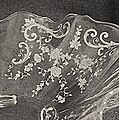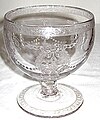
Fire-King is an Anchor Hocking brand of glassware similar to Pyrex. It was formerly made of low expansion borosilicate glass and ideal for oven use. Currently it is made of tempered soda-lime-silicate glass in the US and borosilicate in Japan

Uranium glass is glass which has had uranium, usually in oxide diuranate form, added to a glass mix before melting for colouration. The proportion usually varies from trace levels to about 2% uranium by weight, although some 20th-century pieces were made with up to 25% uranium.
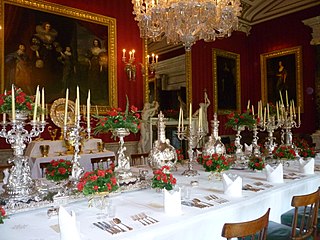
Tableware items are the dishware and utensils used for setting a table, serving food, and dining. The term includes cutlery, glassware, serving dishes, serving utensils, and other items used for practical as well as decorative purposes. The quality, nature, variety and number of objects varies according to culture, religion, number of diners, cuisine and occasion. For example, Middle Eastern, Indian or Polynesian food culture and cuisine sometimes limits tableware to serving dishes, using bread or leaves as individual plates, and not infrequently without use of cutlery. Special occasions are usually reflected in higher quality tableware.

A salt cellar is an article of tableware for holding and dispensing salt. In British English, the term can be used for what in North American English are called salt shakers. Salt cellars can be either lidded or open, and are found in a wide range of sizes, from large shared vessels to small individual dishes. Styles range from simple to ornate or whimsical, using materials including glass and ceramic, metals, ivory and wood, and plastic.

Carnival glass is moulded or pressed glass to which an iridescent surface shimmer has been applied. It has previously been referred to as aurora glass, dope glass, rainbow glass, taffeta glass, and disparagingly as 'poor man's Tiffany'. The name Carnival glass was adopted by collectors in the 1950s as items of it were sometimes given as prizes at carnivals, fetes, and fairgrounds. However, evidence suggests that the vast majority of it was purchased by households to brighten homes at a time when only the well-off could afford bright electric lighting, as its finish catches the light even in dark corners. From the beginning of the 20th century, carnival glass was mass-produced around the world, but largely and initially in the U.S. It reached the height of its popularity in the 1920s, though it is still produced in small quantities today.

Depression glass is glassware made in the period 1929–1939, often clear or colored translucent machine-made glassware that was distributed free, or at low cost, in the United States and Canada around the time of the Great Depression. Depression glass is so called because collectors generally associate mass-produced glassware in pink, yellow, crystal, green, and blue with the Great Depression in America.
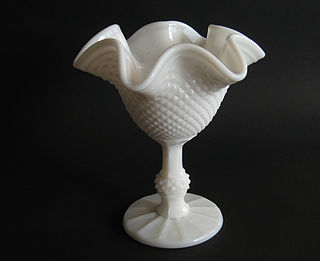
Milk glass is an opaque or translucent, milk white or colored glass that can be blown or pressed into a wide variety of shapes. First made in Venice in the 16th century, colors include blue, pink, yellow, brown, black, and white.

Edinburgh Crystal was a cut glass manufactured in Scotland from c. 1820s to 2006, and was also the name of the manufacturing company. In addition to drinking glasses, Edinburgh Crystal made decanters, bowls, baskets, and bells, in several ranges.

The A.H. Heisey Company was formed in Newark, Ohio, in 1895 by A.H. Heisey. The factory provided fine quality glass tableware and decorative glass figurines. Both pressed and blown glassware were made in a wide variety of patterns and colors. The company also made glass automobile headlights and Holophane Glassware lighting fixtures. The company was operated by Heisey and his sons until 1957, when the factory closed.
The Fostoria Glass Company was a manufacturer of pressed, blown and hand-molded glassware and tableware. It began operations in Fostoria, Ohio, on December 15, 1887, on land donated by the townspeople. The new company was formed by men from West Virginia who were experienced in the glassmaking business. They started their company in northwest Ohio to take advantage of newly discovered natural gas that was an ideal fuel for glassmaking. Numerous other businesses were also started in the area, and collectively they depleted the natural gas supply. Fuel shortages caused the company to move to Moundsville, West Virginia, in 1891.

Sasanian Glass is the glassware produced between the 3rd and the 7th centuries AD within the limits of the Sasanian Empire of Persia, namely present-day Northern Iraq, Iran and Central Asia. This is a silica-soda-lime glass production characterized by thick glass-blown vessels relatively sober in decoration, avoiding plain colours in favour of transparency and with vessels worked in one piece without over- elaborate amendments. Thus the decoration usually consists of solid and visual motifs from the mould (reliefs), with ribbed and deeply cut facets, although other techniques like trailing and applied motifs were practised.
The Macbeth-Evans Glass Company was an American glass company that created "almost every kind of glass for illuminating, industrial and scientific purposes," but is today famous for making depression glass.
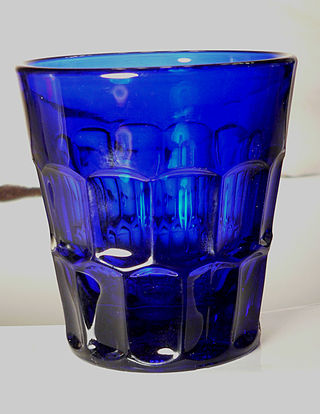
The Hostmaster Pattern was manufactured by New Martinsville Glass Company during the 1930s. Though the line was extensive, New Martinsville Hostmaster Pattern is one of the lesser known patterns of Elegant Glass. There are no reproductions as the mold was melted down to make the Raindrops pattern.

The New Martinsville Glass Company was an American manufacturer of decorative glass products. It opened in 1901 in New Martinsville, West Virginia. The company was renowned for the use of color in their glassware. They initially made tableware but quickly expanded into vanities, bare ware, lamps, and more. They promoted liquor sets even through prohibition. The company was renamed Viking Glass in 1944.
Early American molded glass refers to glass functional and decorative objects, such as bottles and dishware, that were manufactured in the United States in the 19th century. The objects were produced by blowing molten glass into a mold, thereby causing the glass to assume the shape and pattern design of the mold. When a plunger rather than blowing is used, as became usual later, the glass is technically called pressed glass. Common blown molded tableware items bearing designs include salt dishes, sugar bowls, creamers, celery stands, decanters, and drinking glasses.

The china service of the Lincoln administration generally refers to a set of purple-banded china (porcelain) dishes used for serving and eating food at the White House, home of the president of the United States for state dinners. Also known as the Lincoln solferino china service, it was purchased in April 1861 by First Lady Mary Todd Lincoln. The porcelain was manufactured by Haviland & Co. in France, and some of the decoration of the china was made overseas. Additional decoration was made by the American firm of E. V. Haughwout & Co., which sold the china to Mrs. Lincoln.

Pairpoint Glass Company is an American glass manufacturer based in Sagamore, Massachusetts. It is currently the oldest operating glass company in the United States.

Bryce Brothers, also known as Bryce Brothers Company and Bryce Brothers Company Inc., was a glass manufacturing company originating in 1850 at Birmingham, Allegheny County, Pennsylvania that changed names and partnerships until being purchased by the Bryce family when it was moved to Mount Pleasant, Pennsylvania, where they continued to produced blown crystal glassware until 1965.
Indiana Glass Company was an American company that manufactured pressed, blown and hand-molded glassware and tableware for almost 100 years. Predecessors to the company began operations in Dunkirk, Indiana, in 1896 and 1904, when East Central Indiana experienced the Indiana gas boom. The company started in 1907, when a group of investors led by Frank W. Merry formed a company to buy the Dunkirk glass plant that belonged to the bankrupt National Glass Company. National Glass was a trust for glass tableware that originally owned 19 glass factories including the plant in Dunkirk. National Glass went bankrupt in 1907, and its assets were sold in late 1908.
The Lancaster Glass Company was a producer of manufactured glassware in Lancaster, Ohio that ran from 1908 to 1937. They are a producer of depression glass and were known as an early innovator of color in depression-era glassware.




